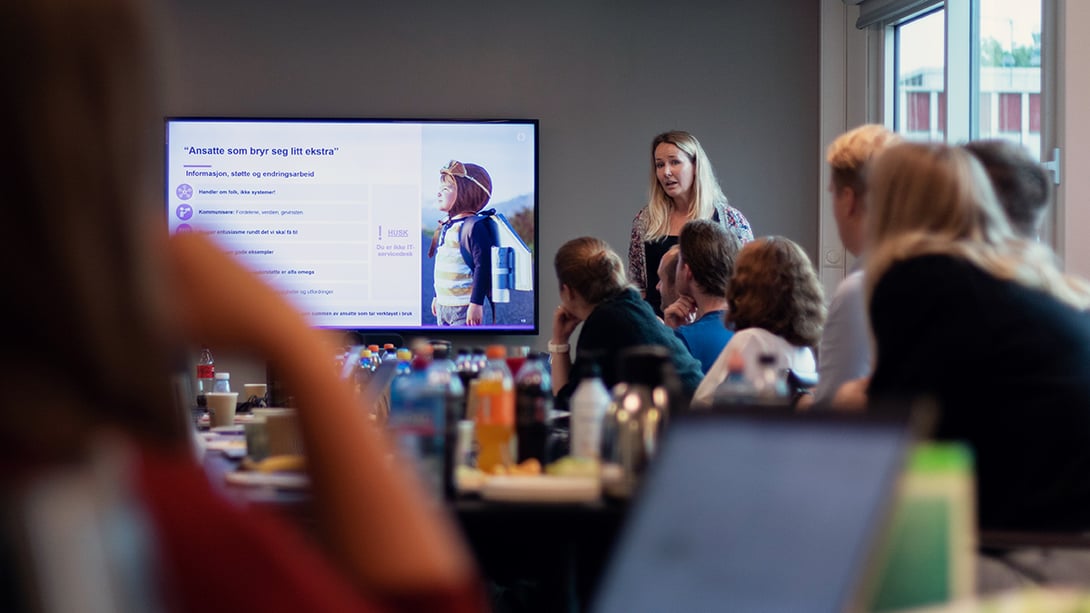Change is exciting when done by us, threatening when done to us. The goal is to get people to choose change, rather than resist it. Easier said than done?

Lise Hansen, Educational Advisor at Puzzlepart.
Individual adjustment is the key to holistic change
The ADKAR model is a recognized theory within change management and, in short, it describes how each of us experiences change. Be it receiving a user account in the cloud or deciding to move from a dear home of the last ten years.
Adjustment and change is a process. For some, it will be a more extensive process than for others. When the status quo is challenged, some form of resistance should be expected, to varying degrees. Our clear advice to organizations about to start rolling out new digital tools is to be well prepared and proactive towards the users.
More interestingly, the ADKAR model addresses how individual adjustment is significant for achieving a holistic and successful transition in the entire organization.
In projects concerning the introduction of new tools and routines, focusing on user adoption is absolutely necessary. At the core, successful user adoption revolves around effective change management. Often, it simply boils down to taking enough time. It's about moving individuals from being aware of change at the onset, to a desire to contribute, and finally in the latter phase, having equipped the individual with sufficient insight and knowledge to use the tool effectively, ensuring lasting change. This process takes time.
Collective Training Fosters Mastery and Positive Experiences
Resistance – and in some cases fear – when introducing new tools often stems from an employee’s faltering confidence in how daily tasks will be executed. Common concerns include "Will I manage to be as efficient?" "How quickly can I adapt?", and "Do I possess the necessary skills?".
A crucial task in all user adoption projects, therefore, is to ensure that employees feel competent as quickly as possible to mitigate the risk of alienation. This is about creating a sense of achievement. We observe that customized, departmental training is highly effective. It feels safe to learn alongside immediate colleagues. By having the entire department step out with the tools and knowledge simultaneously, the likelihood of the new tools being adopted increases, and everyone will have colleagues who have learned the same things and can rely on each other when needed. This creates a collective lift.
The ADKAR model is based on the human nature of taking time to get comfortable with new processes and routines. Allowing room and tolerance for trial and error is a necessary part of the change journey.
A mistake many organizations make is to limit themselves to only basic training. The feeling of inadequacy that some may experience in such a change process is relatively easy to mitigate by taking continuous training seriously. Ensure to offer the employees short bursts of learning, and most importantly, opportunities to go in depth or breadth of a tool.
Regardless of the method, the goal should be that training and communication do not cease after implementation. Create a clear plan for how your organization will ensure that all employees continuously have the opportunity to learn something new or have repetitive learning.
Communication Creates Understanding and Ownership
Good and open communication is absolutely necessary in a project concerning user adoption and, therefore, in change management as well. Most employees appreciate knowing what’s happening along the way, even if not everything has been finally decided. This gives them time to mentally prepare for the changes.
It also turns out that the better understanding the recipients have of the purpose of the change, the greater their engagement becomes. Early in the process, preferably before the decision to implement is made – and certainly well before implementation – it is wise to clearly communicate why a change is necessary and what will change. By focusing on "what and why," we more easily steer away from the how - which often concerns the technical rather than the human aspect - and instead emphasize the crucial selling point of «what's in it for me». A what-and-why focus helps to increase employees' ownership, which can lead to shorter adaptation time and significantly reduced resistance to change.
The Good Ambassadors
As a part of involving employees and increasing the chance for a good flow of communication, we at Puzzlepart have had very good experiences with establishing ambassador networks, preferably early in the introduction projects.
Ambassadors are employees who have volunteered for the service. They are typically proactive employees who care a little extra about helping their colleagues through the change process, and are maybe above average unafraid of change and technology.
The ambassadors receive early training and are equipped to answer questions from colleagues about the changes taking place. Studies also show that it is easier for employees to air their questions, concerns, and joys to a colleague who is an ambassador, rather than a leader, directly to the project team or user support.
For the project, the ambassadors are invaluable because they are close to the organization and have a short reporting line back to the project in case of misunderstandings, concerns, or errors.
It's Always About the People
The goal is to get employees to choose change over resistance, but this requires a methodical and planned approach.
If you ensure proper training, meaningful communication, and a strong ambassador network, you will go a long way. But to rank among the truly skilled, it is still important that the project plans for effective resistance management and adjusts the plans along the way to handle unexpected reactions in the organization.
Successful user adoption is always about people, not technology. With the right focus, the result will be happier employees who feel better about their job.

Lise Hansen
Educational Advisor